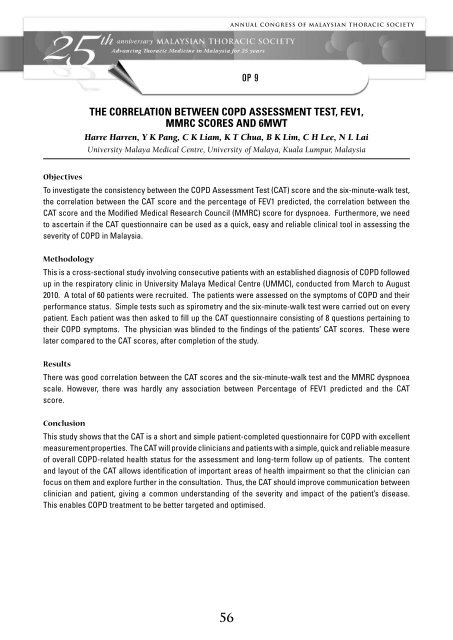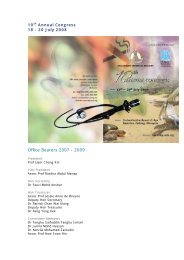download - Malaysian Thoracic Society
download - Malaysian Thoracic Society
download - Malaysian Thoracic Society
You also want an ePaper? Increase the reach of your titles
YUMPU automatically turns print PDFs into web optimized ePapers that Google loves.
Annual Congress of <strong>Malaysian</strong> <strong>Thoracic</strong> <strong>Society</strong><br />
Op 9<br />
The Correlation between COPD Assessment Test, FEV1,<br />
MMRC Scores and 6MWT<br />
Harre Harren, Y K Pang, C K Liam, K T Chua, B K Lim, C H Lee, N L Lai<br />
University Malaya Medical Centre, University of Malaya, Kuala Lumpur, Malaysia<br />
Objectives<br />
To investigate the consistency between the COPD Assessment Test (CAT) score and the six-minute-walk test,<br />
the correlation between the CAT score and the percentage of FEV1 predicted, the correlation between the<br />
CAT score and the Modified Medical Research Council (MMRC) score for dyspnoea. Furthermore, we need<br />
to ascertain if the CAT questionnaire can be used as a quick, easy and reliable clinical tool in assessing the<br />
severity of COPD in Malaysia.<br />
Methodology<br />
This is a cross-sectional study involving consecutive patients with an established diagnosis of COPD followed<br />
up in the respiratory clinic in University Malaya Medical Centre (UMMC), conducted from March to August<br />
2010. A total of 60 patients were recruited. The patients were assessed on the symptoms of COPD and their<br />
performance status. Simple tests such as spirometry and the six-minute-walk test were carried out on every<br />
patient. Each patient was then asked to fill up the CAT questionnaire consisting of 8 questions pertaining to<br />
their COPD symptoms. The physician was blinded to the findings of the patients’ CAT scores. These were<br />
later compared to the CAT scores, after completion of the study.<br />
Results<br />
There was good correlation between the CAT scores and the six-minute-walk test and the MMRC dyspnoea<br />
scale. However, there was hardly any association between Percentage of FEV1 predicted and the CAT<br />
score.<br />
Conclusion<br />
This study shows that the CAT is a short and simple patient-completed questionnaire for COPD with excellent<br />
measurement properties. The CAT will provide clinicians and patients with a simple, quick and reliable measure<br />
of overall COPD-related health status for the assessment and long-term follow up of patients. The content<br />
and layout of the CAT allows identification of important areas of health impairment so that the clinician can<br />
focus on them and explore further in the consultation. Thus, the CAT should improve communication between<br />
clinician and patient, giving a common understanding of the severity and impact of the patient’s disease.<br />
This enables COPD treatment to be better targeted and optimised.<br />
56








